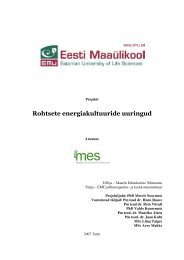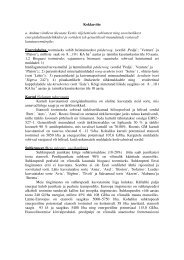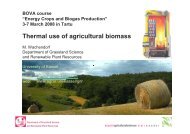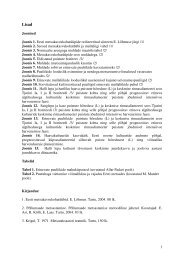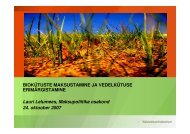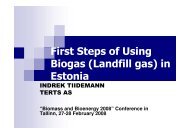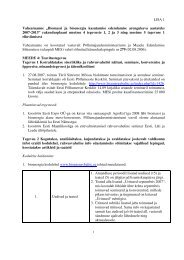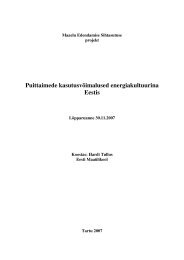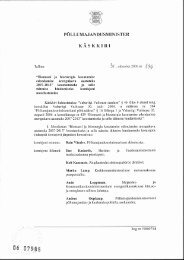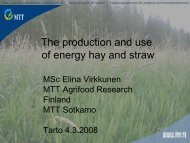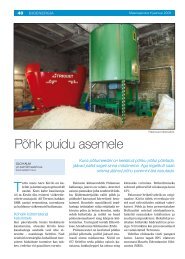Põllumajandusministeeriumi ja Maaelu ... - bioenergybaltic
Põllumajandusministeeriumi ja Maaelu ... - bioenergybaltic
Põllumajandusministeeriumi ja Maaelu ... - bioenergybaltic
Create successful ePaper yourself
Turn your PDF publications into a flip-book with our unique Google optimized e-Paper software.
16. Smart energy networks (DG TREN and DG RTD)<br />
17. Energy savings and energy efficiency (DG TREN)<br />
18. Knowledge for energy policy making (DG TREN and DG RTD)<br />
PRODUCTION OF BUILDING MATERIALS, BIOPLASTICS AND OTHER<br />
MATERIALS FROM BIOMASS. USE OF BIOMASS AND RELEVANT<br />
DEVELEOPMENT TRENDS<br />
There are several possibilities to produce various polymers which in European Union are<br />
conventionally called bio-based polymers (BBP). A composite material containing one or<br />
several bio-based polymers is named bioplastic, mainly due to the marketing considerations.<br />
Such a composite consists of the blend of different polymers and significant amount of<br />
additives known as compounders which are of synthetic or mineral origin. Erroneously it is a<br />
ubiquitous understanding that bioplastics are a priori biodegradable. As a matter of fact, only<br />
certain types of bioplastics are biodegradable. Some BBP are extremely stable, both thermally<br />
and chemically as well as mechanically (e.g., Rilsan). In the course of development of the<br />
main BBP types, first their biodegradability has been reduced. In many biodegradable<br />
composites the biodegradability is achieved and modified by respective polymers and<br />
additives that are purely chemically produced.<br />
The BBPs are classified in different documents and somewhat according to the interests of<br />
entrepreneurs. That is why polymers composed of so-called potentially bio-based monomers<br />
are named BBPs, although due to the price policy, these polymers are actually produced<br />
synthetically.<br />
BBPs can be divided according to their biomass ratio:<br />
a) natural or chemically modified biopolymers,<br />
b) polymers composed of completely or partially bio-based monomers.<br />
The only natural biopolymers, which are used purely as bioplastics today, are<br />
polyhydroxyalkanoates (PHA). For the production of PHA selected bacteria are cultivated,<br />
bacterial biomass is lysed, followed by dissolving PHA from the lysed biomass by chemical<br />
solvents. There are two large groups of modified BBP which are produced by processing<br />
starch or cellulose, respectively. A large group of various polymers with distinct and different<br />
characteristics is based on the both named raw materials. However, the starch modified group<br />
is more important in the meaning of production capacity whereas thermoplastic starch forms<br />
its majority. Based on different opinions, the starch-based polymers form altogether 50-80%<br />
of the BBP used in bioplastics. The production involves chemical restructuration, several types<br />
of (trans)esterification and etherification steps. Despite of a long application experience,<br />
during the last decade the application of modified cellulose-based polymers has been<br />
remarkably reduced, which is caused by the power and raw materials consuming cellulose<br />
purification processes. Although the chemistry of cellulose production is quite similar to that<br />
of starch, the conditions are harsher.<br />
Polylactic acid represents a biopolymer completely produced from biological raw material and<br />
according to the production aspects is defined as polylactide (PLA). The monomer for PLA is<br />
produced via glucose fermentation to lactic acid, whereas purification of lactic acid and<br />
sequential polymerization are parts of labour-intensive, energy and raw material consuming<br />
chemical industry. Actually the pure PLA plastic is very rare in the market and the proposed<br />
PLA-polymers are to a greater or lesser extent the mixed esters of lactic acid and synthetic<br />
monomers (e.g., the mixed ester of lactic acid and glycolic acid – PLGA). The other important<br />
groups of partially bio-based polymers are polyamides and polyurethanes. The production of<br />
these plastics is practically identical to the conventional petroplastics; only with the difference<br />
that one raw material is of agricultural origin.<br />
113




